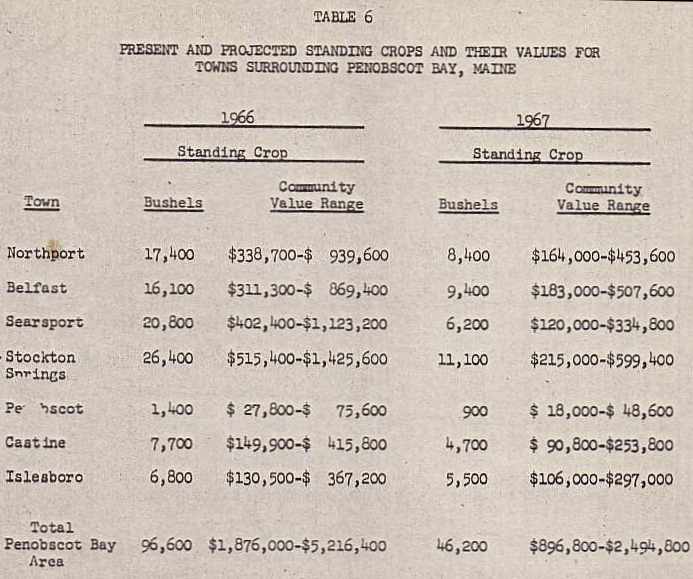Upper Penobscot Bay Shellfish Survey 1966-1967
Study Leader: Herbert Pahren, Dep. Regional Dir, Federal Water Pollution Control Administration.
From: Conference in the Matter of Pollution of the Navigable Waters of the Penobscot River & Upper Penobscot
Bay in the State of Maine.
Held on Thursday, April 20, 1967, at 9:45 a.m. at the Belfast High School, Belfast, Maine.

INTRODUCTION
About 90 percent of the shore surrounding upper Penobscot
Bay was surveyed for soft-shell clam resources. The areas
not surveyed were either industrial complexes or estimated
very low producing areas. The coves proved to be the most
productive areas for clam growth. The remaining shoreline
contained clam populations interspersed with scattered boulders
and rock outcrops.
The most productive clam areas were Stockton Springs and Searsport, followed by Northport and Belfast. The remaining Towns of Penobscot, Castine, and Islesboro were not completely surveyed, which accounts partially for their low total figures.
Population estimates
For the total area of Penobscot Bay affected by the recent shellfish closures, the estimated population was placed at 96,000 bushels of marketable soft clams, valued from a community standpoint at $1,876,000 to $5,216,400.
Potential earnings during a second season are estimated to be 46,200 bushels. These would have a market value to the community of from 896,800 to $2,494,800 in 1967 dollars.
Marketing of clams.
In July 1966, the effective date of the total closure of Searsport and Stockton Springs for harvesting clams and other marine mollusks, there were 53 licensed diggers in the two towns. About 32 were full time diggers; the rest dug clams occasionally.
The town of Searsport allows non-residents to tke up a peck a day from their flats. A varied number of people from nearby towns and cities dig for fun on weekends and holidays. This past year (1966), during the Memorial Day weekend, the local Sea and Shore Fisheries warden counted 500 sport diggers in Long Cove and along the eastern shore of Sears Island. Each digger could legally take a peck of clams. Better than 100 diggers area usually found on these flats on weekends and holidays from May through October.
There was swimming to some extent near Bayside in Northport, but recently grease and feathers in the water have made people reluctant to swim.
Clam Resources
In past years the Penobscot Bay area has been
noted for being one of the most productive areas in Maine for
harvesting softshell clams. Today, all the growing
areas in the upper Penobscot Bay are closed due to pollution.
In order to determine the amount and value of the clam resources being affected by the pollution, a study was carried out by the Shellfish Sanitation Branch, United States Public Health Service, during the summer of 1966.
The area affected by the pollutional discharges includes the towns of Northport, Belfast, Searsport, Stockton Springs, Penobscot, Castine and Islesboro (Figure 23).
-----------------------------------------------------------------------------